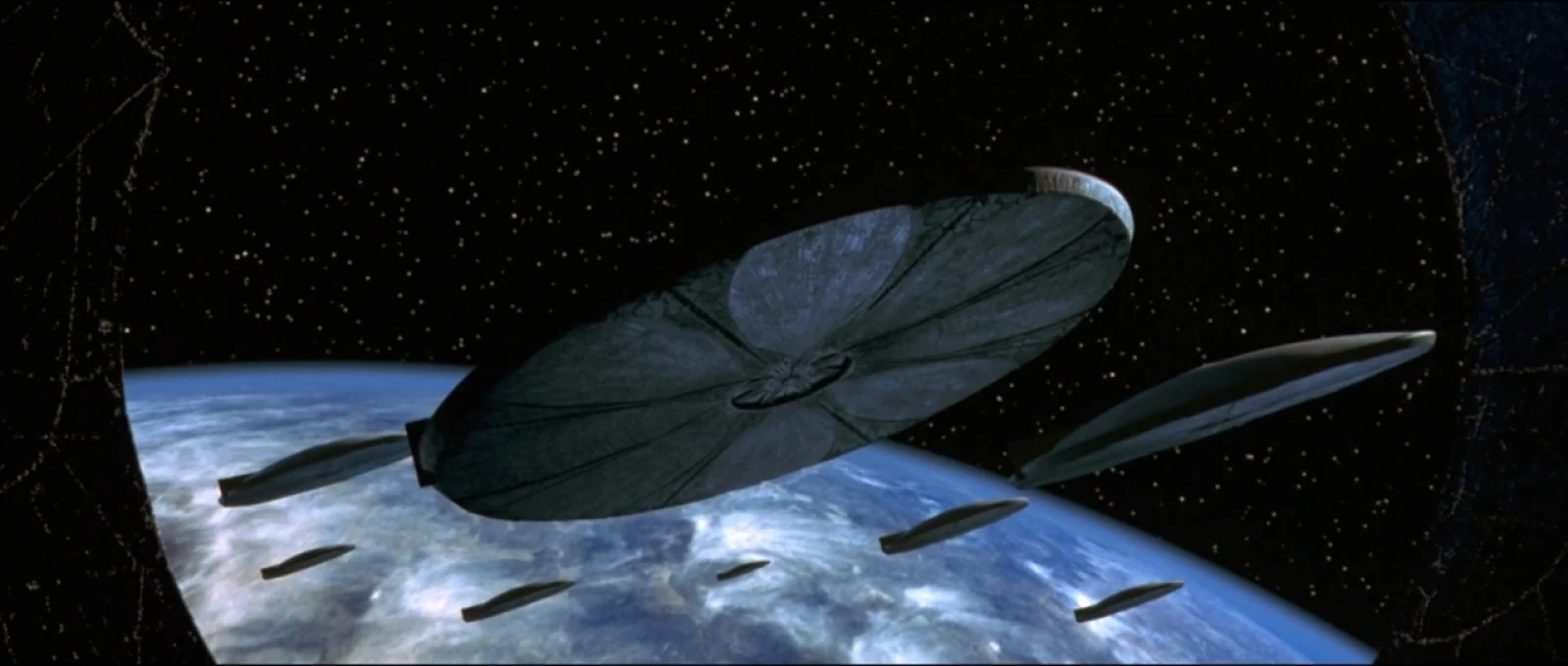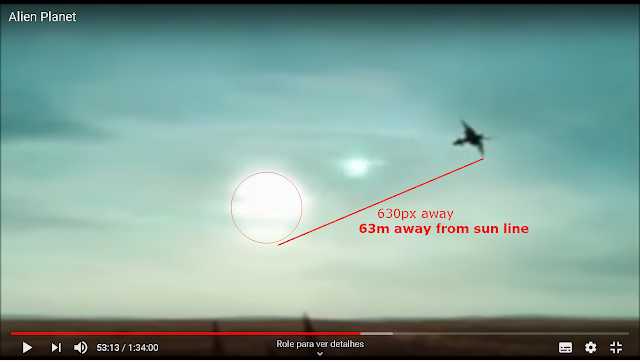MAYBE SPACE IS LIKE THE SEA...
...OR IS IT?
When your enemy fire lasers and don't even have shields
After reading some comments on forums about that post in particular, and some other discussions on the theme, I decided to make a follow up post, as an extended argument - exploring in-universe ideas so we make sure we are at least, certain we are exploring the world to it's potential.
Before you all point the phasers and blasters at me, I would like to again state that I'm trying to get Hard Sci-Fi on the matter, ie, try analyze the viability of an aspect, based on what we know today - when talking about in-universe logic, I will do as I often do discuss conspiracy theories and not poke the HOW, but poke the AFTER of an aspect, and try to see if the observed consequences to a certain aspect are really the ones that would apply - ie, in this case, let's just accept it is possible in the first place, and then explore what would actually happen after.
In relation to Star Trek in particular, as I noticed it is an often brought up topic, which is rather, unusual? From my POV at least - I mean, every other universe has it's little bit of "nonsense" (fiction), I personally included Magic and a mechanism in which it is "possible" in my stories, so again, it isn't like I'm a science-nazi - coming back to Star Trek, it is unusual for me that, besides some in-universe stuff makes real sense, some major plot points just don't, like the characters not using spacesuits every time they go on ground missions.
Yeah, let's lay on the soil of a alien planet, just the kind of place that contain most of the foreign and potentially harmful microorganisms possible - after the insides of an alien itself
WHAT WE DISCUSSED IN THE PREVIOUS POST
After taking a look at some problems, and how they could be solved, regarding navigation and protection, I have established 4 rules for spaceship design.
RULE 1
A spaceship will be always under the Newton's 3 laws, and as such, will not suffer friction in space and decelerate if stopped it's engines, and will continuously accelerate if it continuously fire it's engines.
A spaceship should be able to move in all 3 axes, in both negative and positive vectors of those, for stable navigation and positioning in space.
RULE 2
Windows, are a
weak spot, no matter what they're made of, what worries is not that they
could break, is that they do expose the interior to dangerous
radiation, as explained in FTL DEPICTION, near light-speed and faster-than-light travel expose the ship hull to dangerous UV, X-rays and Gamma radiation.
As well, in
cruisers and aircraft carriers, is fairly natural that the majority of
the crew do not see the sun for the entirety of the mission - nothing
too strange so far.
So, little to no windows across the hull, if there is windows, make sure they are slim and can be shielded at any moment.
RULE 3
We don't need an external horizon sense - Up or Down sides of a
ship, we would want to make it cylindrical or with as many symmetry
axes as we can, to make steering and defense evenly possible across the hull.
RULE 4
Heat is a
serious problem. On Earth, vehicles, weapons and people can exchange
heat with the environment. In space, we need to deal with irradiation of
heat, the ship needs to get rid of extra heat from it's functioning and
exposure to sunlight, the problem is to balance the compactness of space
ship with the large area needed to irradiate it away at a decent rate.
For this, we
would never want to coat our ship in black paint or use dark materials
to construct it's hull. Make it visually as bright as possible is the
way to go, or at least as reflexive into the UV and Infrared as
possible.
Rules 3 and 4 was also kind of applicable to WWI, in the form of Dazzle Camouflage,
which disrupts a ship's silhouette at the distance, making it harder to
tell direction of movement, or weakpoints unless you observe it for a
long period of time, a precious time in war. More on that later.
THE DISCUSSION
Now let's take a look at some points regarding that post.
Rear-facing engines are a N O P E, or are they?
What one is doing when building large rear-facing engines is sacrificing
agility for linear acceleration and in some cases this makes sense.
Ironically, the hard scifi setting that he describes would be one that
might favor linear acceleration to some extent. After all if you have
several seconds to react to enemy fire then you only need a certain
amount of agility. On the other hand, linear acceleration in such a
setting is your strategic mobility.
In what way this makes any sense I have no idea, unless both sides agreed to have a medieval jousting, moving only forwards, and the one who shoots first has MORE chance of winning.
whooosh!
In the case of only rear-facing engines, and that you would have several seconds to react, it is true to an extent - except there ain't much you can really do in space in that situation, but to accelerate and rush through the enemy line of fire. Again, it's not the sea, so you don't have tiny little flaps in your ship's hull to steer it in any other direction, so Linear Acceleration isn't really an option.
In the case of the ship having other thrusters, which would be ideal, you have way more options of evasive maneuvers, however, these thrusters should be able to turn or move your ship around within a certain degree of freedom, in which case, if they would be considerably less powerful than your main thrusters, you then just gave your ship a large and predictable turning circle.
Turning circle of the RMS Titanic in a presentation about evading that one iceberg
Giving your ship a large turning radius can be considered a great problem because maneuvers may take on some considerable time, and space that may not be available for your because of the enemy line of fire or physical obstacles.
If the ship has several thrusters of similar power, they can overcome the issue in any direction within the same safe window of time, or at least, rotate the ship in order the evade incoming fire.
Just imagine how many times would Neo have been shot - if his only option was to run towards Agent Smith.
Ships have no real reason to be within visual distances from one another in the...
STAR TREK UNIVERSE
Let's first consider:
- Virtually all ships are capable of superluminal travel (FTL), and tracking objects at these velocities.
- Virtually all ships have some level of energy/force shielding.
Given these factors, it actually make sense that ships would have to get
damn near face to face in order to harm each other, look at how
dismissive Worf was about that one alien ship using lasers as it’s
primary weapons, it implies that they’re near to completely useless
against proper shields and that doesn’t even touch on the trek ships
just being able to warp out of the way of the laser beam (assuming that
they noticed it being fired from a light-second plus range, which I give
like 50/50 odds).
The other big thing about the shields is that the
debris clouds from defeated ships become much less of an issue as even
the deflector shields (the ones used at warp speeds to keep the ship
from getting turned into an expanding cloud of debris by those various
hydrogen atoms floating a few feet away from each other) should be able
to handle that considering what they’re actually meant to do.
On the
other hand, at much closer distances charged particle weapons become much
more effective and devastating as the beam doesn’t have time to spread
out as it would over vast distances like it would for light-seconds and
beyond and they’re able to carry enough energy to chew away at the opposing side’s shields.
So are we lead to attack at close range because ranged weapons are virtually ineffective against those ships. And somehow they can't really fire relativistic weapons at these distances, when their enemy wouldn't have 2 billionths of a second worth of time to process any data and plan ahead at all... Yeeeaa?
Or the fact that lasers would actually be more useful than charged particle weapons, because photons have no charge, if the shielding blocks the incoming fire through detecting the electric potential of physical projectiles, then yes it would make lasers or photon torpedoes the most efficient kind of weapon against conventional treknology. What again, bring back the relativistic weapons a plus, as it doesn't need to directly hit the target, any sufficient large debris like an asteroid or probe sent with this exact purpose can blast sufficient X-rays and Gamma rays to blind, fry, and overheat the ship's crew and hull.
So yea, the Federation would then opt for maintaining a safe distance in order to avoid being fried by RWs, while also close enough to launch efficient ranged subluminal projectiles.
Given the USS Enterprise lenght is about 642,5m, I'm pretty sure that 2,5km is NOT the UFP's minimum safe engagement distance
Star Trek indirectly states that RWs are a common type of weapon, and the battles take on having thousands of kilometers between ships - so most of the great battles we remember from the movies are abnormal cases.
Except on the case for Star Wars :(
CAMOUFLAGE IN SPACE?
Here is how NASA identifies asteroid sizes:
Different sized objects with varying compositions may be at first indistinguishably at distance, because a larger reflective area with a lower albedo can compensate for a smaller reflective area with higher albedo, however that's how visible light interacts with matter.
In the Infrared spectrum, darker objects absorb more heat energy than whiter objects, and thus, these objects passively glow in infrared to some extent.
Assuming two objects are the same distance from the Sun, and that they are so small their internal heat is negligible. The only thing affecting their temperature is their size and albedo.
Assuming they'd have the same albedo, the larger object has more surface area to receive heat from, and would be hotter.
The problem with camouflage in space is the fact that space is rather full and empty at the same time.
In a way, you can never be fully mix in the environment, you either will emit more energy than your surroundings or be colder than it, either way, they see you.
For perspective, the Voyager 1 uses beamed radio signals directly at Earth to communicate, these beams are only 23W in strenght, as of 2014, when Voyager 1 was at a distance of 100 AU, the signal strength here on Earth was that of a billionth of a billionth of a Watt (≲1 attowatt).
As of 8 june 2020 (today), Voyager 1 is still rather contactable, and at ~148,67 AU the signal is only 45,6% as strong as in 2014.
A relatively light 2.500 ton ship made of steel, 10K above background noise temperature bears about ~3,2MWh worth of energy - from a 100 AU distance to the observer, it's signal would be about 141,7 thousand times brighter than Voyager 1. At 1 AU, the signal strenght is of ~1,4 nW.
Now imagine the massive cruisers in popular sci fi movies, again the USS Enterprise, which weights 4,96 million tons, and as nobody seems freezing inside the ship, I can only assume it is at LEAST about 15ºC, or ~288K, temperature of objects in the Kuiper Belt at 40 AU are no hotter than 50K, at 100 AU then, the Enterprise would be the only glowing object in the Infrared spectrum.
Early 21st century techonology (a.k.a. current tech) can swipe across the skies in a matter of hours - less than an entire day, you don't even need a full celestial scan for this kind of purpose, if you're expecting the enemy to come a particular direction, like the Gas Giants of your system - if they need gravitational assists to maneuver. We can even detect distant planets hundreds of lightyears away using slight variations in starlight.
If an interstellar/interplanetary invasion is a true concern to the world it takes place, you can deploy radars or telescopes in the lagrange points of other planets or in an inner orbit around your parent star, in this way, you can rely on both paralax between your ship's POV and the radar's POV in relation to a target to range it, if we with current technology can spot and track the dimmest objects, a society really concerned with the matter may really make sure it can really know what's up there.
It isn't like we won't notice them coming until they cross the Lunar perimeter.
DISRUPTIVE CAMOUFLAGE IN SPACE THEN?
Based of that, and the fact combats would indeed take place within non-visual ranges, but would still be detectable right away, we can design camouflage add-ons to make way harder to estimate the size and specific shape of the ship instead.
This could be done by either painting the ship or by adding reflective or absorbent panels to the ship, to make it appear smaller or bigger (more distant or more closer) than it really is and thus throw the first enemy shots off by some hundreds or thousands of kilometers.
Mobile reflective plating could easily flash the reflectivity of the ship with a random stroboscopic effect making it virtually impossible to pinpoint in 3D space within a certain range - making for a real Space Dazzle Camouflage.
The use of this techinique can also counter-shade the ocultation of background stars or celestial bodies, to the point that your ship's passage in front of a star or distant planet can be mistaken with background noise - in which case, you would need to have the slight idea from where they might be watching you so you can beam the light in the right direction.
Other forms of space camouflage could be the releasing volatile chemicals such as ammonia, water and methane - to disguise as a comet, though they would look at you even more because of the new comet.
Navigating on the shadow (blocked part of the sky) of a planet could be quite effective until you're close enough to "rush" towards your target - this would require you to know well the planetary motions of the target system. Like, despite the Enterprise being several orders of magnitude brighter than the Voyager 1 for instance, or brighter than the Kuiper Belt objects, it could pretty much hide behind Jupiter down to 5,2 AU into the system.
Omni-directional radio emissions would be rather stupid as well, a more delicate but safe method is needed, low energy beamed / laser communication would be more viable between ships in a fleet, at sub-AU distances, 24W comms may be even an overkill in energy / data transmission, beamed comms can't be intercepted unless the enemy is in between the transmissor and the receiver, plus into the beam's cone.
And that's all I can think on the topic without being redundant about some obvious factors like the inverse square distance law, or throwing in handwavium hulls.
The thing is, even though you can be detected on the system's edge, there will be probably weeks before you both can engage in any meaningful combat, unless you travel at near lightspeed or superluminal speeds, a couple hours or minutes at least, in which case, all this camouflage thing may be a waste of time if you can just hop in and out range without warning. And even so, it isn't so feasible the combat may occur within more than a Lunar Distance (about 400.000km) away unless at least one side has mastery on RWs.
- M.O. Valent, 09/06/2020























